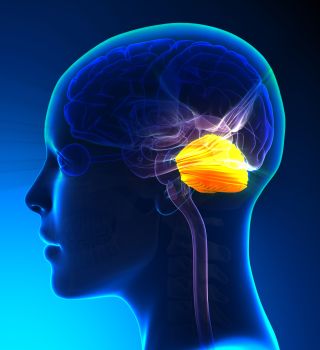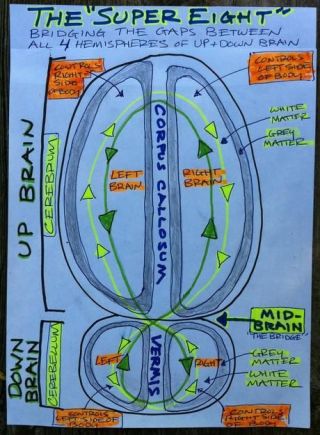Memory
Cerebellum Stimulation Boosts Older Adults' Episodic Memory
How does cerebellum neurostimulation enhance learning and memory?
Posted May 2, 2023 Reviewed by Michelle Quirk
Key points
- The hippocampus ("memory hub") and prefrontal cortex have long been associated with age-related cognitive decline.
- More recently, the cerebellum ("little brain") has become a focus of memory-related neuroscience research.
- New findings suggest the possibility of a long-lasting nonpharmacological intervention to ameliorate age-related cognitive frailty.

For centuries, the cerebellum was considered a motor-function-only brain region that coordinated smooth and accurate muscle movements but didn't play a role in cognition. Most neuroscientists didn't think the cerebellum played a role in nonmotor brain functions or cognition until the late 1990s, after Jeremy Schmahmann identified and coined the term cerebellar cognitive affective syndrome in 1998.
Before 1998, damage to the cerebellum was primarily associated with motor syndromes like cerebellar ataxia and dysmetria.
Since the early 2000s, accumulating evidence suggests that different microzones within the left and right cerebellar hemispheres play a vital role in optimizing how the whole brain works in concert to facilitate higher executive functions like working memory, linguistic processing, spatial cognition, social mentalizing, and emotion regulation.
Much like the cerebellum coordinates smooth, fluid movements and promotes superfluid athletic performance, different parts of the cerebellum's left and right hemispheres help to coordinate thought processes and may facilitate superfluid thinking.
For years, we've known that damage or deterioration of certain cerebellar regions affects the whole brain's cognitive capacity and can result in what Schmahmann calls "dysmetria of thought." Now, new research suggests that stimulating the right cerebellum enhances the brain's ability to learn and remember.
Stimulating the Right Cerebellum Improves Episodic Memory
A new study (Almeida et al., 2023) into the cerebellum's role in cognitive functions found that stimulating the right cerebellar hemisphere with anodal transcranial direct current stimulation (tDCS) improves episodic memory in older adults over age 60. These findings were recently published in the peer-reviewed journal GeroScience.
"Here, we show that the cerebellum plays a causal role in episodic memory performance and aging-related [cognitive] decline and that age-related episodic memory decline can be reduced in a long-lasting way with neurostimulation to the right cerebellum," the authors explain.
For this 12-day study, first author Jorge Almeida and colleagues randomly assigned study participants to one of four groups. Only one group received anodal tDCS to the right cerebellum for 12 days. Another group received anodal tDCS to the left prefrontal cortex during this time. The remaining groups were used as controls and didn't receive actual tDCS neurostimulation but instead were put on a waitlist or received sham tDCS treatment.
The researchers tested participants' verbal episodic memory using the Free and Cued Selective Reminding Test (FCSRT) at three different time points: before the study began, one day after the 12-day study ended, and four months after the study concluded.
Notably, those who received anodal tDCS to the right cerebellum were the only participants with significantly better FCSRT scores immediately following 12 days of neurostimulation and four months later at a follow-up evaluation.
"Memory performance enhancement greatly outlasts the [12-day] stimulation period," the authors explain. "Moreover, all individuals in the right cerebellum anodal tDCS experimental group showed memory performance improvements at the follow-up evaluation time [four months later]."
Neurostimulation of the Right Cerebellum Enhances Memory-Related Connectivity

Interestingly, Almeida et al. found that subcortical anodal tDCS to the right cerebellum improved its structural and functional connectivity with the hippocampus and other cortical brain regions involved in episodic memory.
As the authors explain, "Immediate effects of tDCS to the right cerebellum on the functional connectivity of the hippocampus were observed over a series of regions that are majorly involved in many of the processes that are central to episodic memory, and thus are important to sustain enhancements of episodic memory performance."
The Main Takeaways From This Study
Stimulating the right cerebellum improves episodic memory in older adults for at least four months after a 12-day treatment. Noninvasive anodal tDCS to the "little brain" also changes the cerebellum's functional and structural connectivity with the hippocampus and other cortical regions in the episodic memory network.
The authors conclude that neuromodulation of the right cerebellum can improve long-term episodic memory. They also posit that these findings demonstrate a "causal role of the cerebellum in high-level cognitive processes—specifically in episodic memory."
In an April 2023 news release, Almeida summarizes the clinical implications of his team's latest findings: "[Our] work opens up the possibility of developing non-pharmacological interventions to ameliorate typical age-related cognitive frailty that induce long-lasting improvements that, at least, outlast the four months tested herein."
Optimizing Connectivity Between All Four Brain Hemispheres

For decades, I've been fascinated with how the right and left cerebellar hemispheres work in concert with the cerebrum's "left brain-right brain." As a young right-handed tennis player, my neuroscientist father taught me that the right cerebellum works with the left cerebral hemisphere to control the right side of the body.
During my years as a professional athlete, I was always intrigued by the crisscrossed connectivity between the cerebral and cerebellar hemispheres as it relates to superfluid coordination and peak performance. (See The Split-Brain: An Ever-Changing Hypothesis.)
In 2009, I drew a brain map (see illustration, left) using some highlighters and Sharpies that showed a birds-eye view of all four brain hemispheres squished down onto a two-dimensional plane. The yellow and green bidirectional arrows form a "Super 8," illustrating how structural and functional connectivity might flow between all four hemispheres in ways that help the whole brain function better.
Looking at this brain map through the lens of Almeida et al.'s latest (2023) research, it seems plausible that targeting the right cerebellum kickstarts a chain reaction that enhances structural connectivity between different hemispheres and, in doing so, helps to optimize whole-brain functionality.
References
Jorge Almeida, Ana R. Martins, Lénia Amaral, Daniela Valério, Qasim Bukhari, Guilherme Schu, Joana Nogueira, Mónica Spínola, Ghazaleh Soleimani, Filipe Fernandes, Ana R. Silva, Felipe Fregni, Marcel Simis, Mário Simões & André Peres. "The Cerebellum Is Causally Involved in Episodic Memory Under Aging." GeroScience (First published: February 07, 2023) DOI: 10.1007/s11357-023-00738-0




